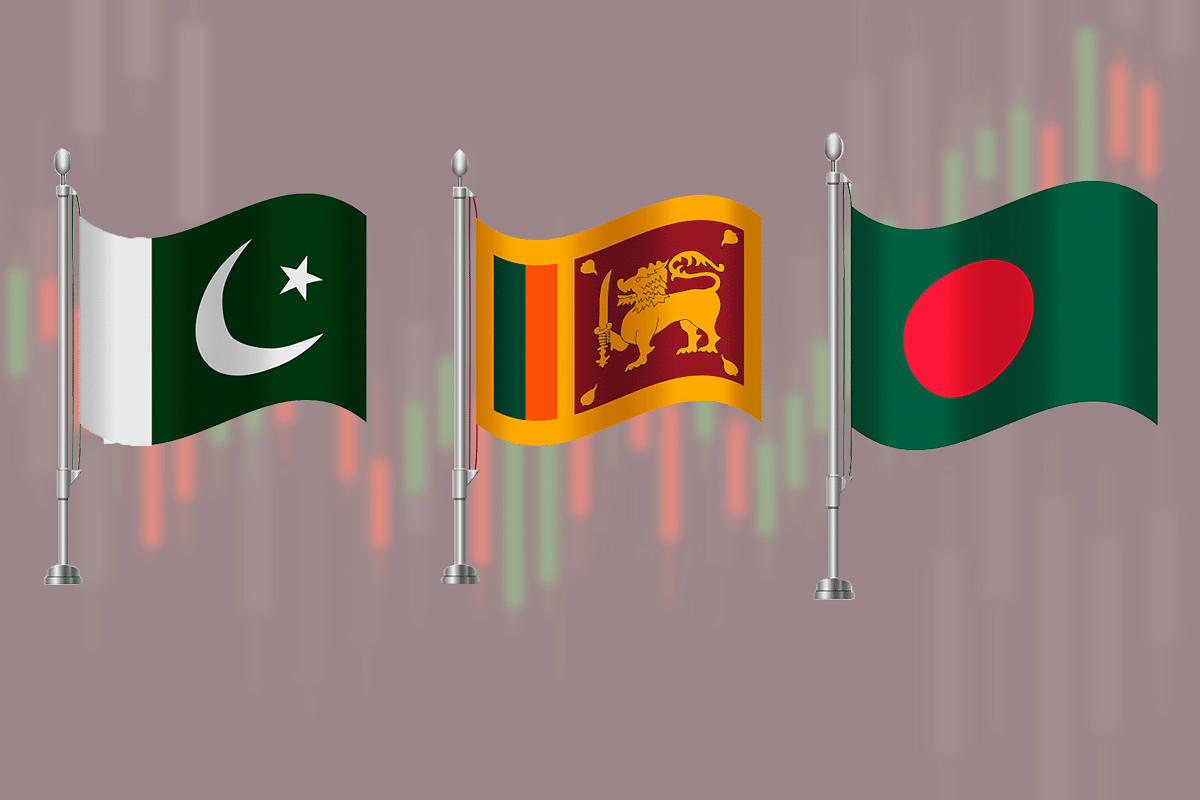World
It’s Getting Worse For India’s Neighbouring Economies
- India’s neighbouring economies are now faced with soaring debt and high inflation.
- Going by the weak global forecasts for 2023, the road ahead does not look great for Sri Lanka and Pakistan.

Economic challenges in Pakistan, Sri Lanka and Bangladesh
The economies of Bangladesh, Pakistan, and Sri Lanka are faltering. Hit by the pandemic, the war in Ukraine, and the tightening monetary policy of the Federal Reserve, India’s neighbouring economies are now faced with soaring debt and high inflation.
The weakening economy in these countries will have geopolitical consequences as well, given both India and China, as creditors and critical trade partners, would want to increase their strategic leverage.
In Sri Lanka, in July 2022, the annual per cent change in the consumer price index was as high as 66 per cent. It was 58.9 per cent in June 2022, and 45 per cent a month earlier in May.
Since the start of the year, the country has witnessed exponential growth in inflation with a sharp fall in the gross domestic product (GDP), resulting in stagflation. Even the $2.9 billion bailout from the International Monetary Fund (IMF) is unlikely to reverse the nation’s economic fortunes.
Sri Lanka’s economy is expected to contract by 8.7 per cent in 2022. The economic mismanagement in Sri Lanka must be attributed to the Rajapaksa dynasty. Rising commercial borrowings with high-interest rates and shorter payback periods have wrecked the economy.
Further, policy disasters like the ban on the import of fertilisers, a sharp cut in taxes, and an ultra-loose monetary policy between 2019 and 2021 have only accelerated the downfall.
In Sri Lanka, as with Pakistan as well, there is the China factor. Unplanned infrastructure projects that gave a temporary economic boom to the island economy in the 2010s are now warranting servicing of debt. Of the $50-odd billion debt, the country has, at least one-fifth of it is owed to China.
The crisis in Ukraine and the strengthening dollar have resulted in Sri Lanka’s rupee falling by over 40 per cent in September 2022 (year-on-year), and the foreign reserves coming down by more than 42 per cent since the beginning of the year.
The regime in Colombo would be eyeing the IMF bailout in December desperately. However, a lot will boil down to how the country negotiates with its creditors, mainly China, India, and Japan.
While the three creditors, along with the United States, would be looking at supremacy in the Indian Ocean, for Sri Lanka, it is getting the economy back in shape.
Thus, accepting short-term debt relief with long-term haircuts from China would not be unacceptable for Colombo. However, that will stoke other creditors, especially India, the wrong way.
Pakistan’s economy has been on the brink of collapse for over a decade now. In August 2022, the annual change in consumer price index was over 27 per cent, the highest in 14 years. Even before the pandemic, inflation increase in percentage was in double digits.
Forecasts, after the devastating floods that resulted in huge losses to agriculture and infrastructure, are pegging inflation at more than 35 per cent. Since the start of 2022, foreign reserves have fallen by 45 per cent and the local currency by over 25 per cent.
Beyond the $60 billion investments in the China-Pakistan economic corridor, Beijing loaned out $2.3 billion to Islamabad in June earlier this year to aid their depleting foreign reserves.
Another IMF loan worth $1.1 billion dollars is also in the works post the floods. The total debt, however, owed to China now exceeds $30 billion, with no sustainable way of debt servicing anywhere on the economic horizon.
Already, a United Nations policy paper has argued for debt restructuring and suspension of some international payments for Pakistan. The total debt of the country now exceeds $100 billion.
The paper argues for creditors to take a haircut on the loans made in return for Pakistan to invest in climate-resilient technologies for the future. In the beginning of the month, as much as one-third of the nation was submerged due to flooding, as per satellite data.
The story is no different in Bangladesh, once hailed by the economists in India for its export model. From over $45 billion in 2021, Bangladesh’s foreign reserves have come down to around $38 billion, given the rising crude prices worldwide.
Food inflation, as per some estimates, is now touching 50 per cent, resulting in lower purchasing power and a long-term dent on the economy.
Bangladesh, however, is far from being a Sri Lanka or Pakistan right now, given the lower levels of debt. In July 2022, Dhaka reached out to the IMF for a multi-billion dollar assistance, around $4.5 billion, given the macroeconomic challenges the country was facing.
Looking at foreign reserves that could only make up for five-months worth of imports after July, the country was banking on its development model to secure the loan.
The weakened economies could soon become a battleground for the strong economies to settle their diplomatic scores and exercise their geopolitical might, as creditors and trade partners.
Going by the weak global forecasts for 2023, the road ahead does not look great for Sri Lanka and Pakistan. For the neighbouring economies, it will get a lot worse before it gets any better, but at what cost, for them, and for India?
Also Read:
Introducing ElectionsHQ + 50 Ground Reports Project
The 2024 elections might seem easy to guess, but there are some important questions that shouldn't be missed.
Do freebies still sway voters? Do people prioritise infrastructure when voting? How will Punjab vote?
The answers to these questions provide great insights into where we, as a country, are headed in the years to come.
Swarajya is starting a project with an aim to do 50 solid ground stories and a smart commentary service on WhatsApp, a one-of-a-kind. We'd love your support during this election season.
Click below to contribute.
Latest